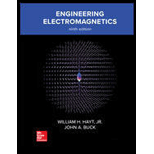
(a)
To prove:
H is not the function of
Explanation of Solution
Given:
The radius of the hollow cylindrical shell is 'a' which is centered on the z -axis and it carries a surface charge density of
Concept Used:
In this concept, Ampere's circuital law will be used. The law of Ampere states the relationship between the magnetic field and the current one. It says that the closed integration of the magnetic field along the path is equal to the current product contained in the path and the medium. The mathematical expression is given as-
Where,
H = magnetic field
Ienclosed = current within the path
Calculation:
As given a hollow cylinder with a radius of 'a' which is centered on the z-axis.
The surface charge density of this cylinder is
Hollow cylinder along with amperian loop around it shown below-

From the above diagram, the value net charge within the loop is zero.
Amperian loop, when the surface charge current element within this loop is given below-
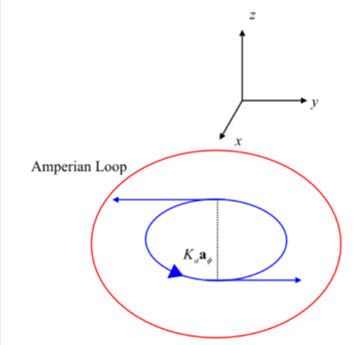
From the above diagram, the direction of the tangent of the current element is aywhich is situated at the diametrically opposite end of the direction of the current element which is -ay.In the same way, every current element's tangent is situated exactly opposite to the direction of the current element.
With this condition, the total charge is canceled out and it will become zero. Therefore,
From, Ampere's circuital law-
So, H =0. This explains that there is no magnetic field outside the cylinder.
Now, create a loop around the hollow cylinder which passes through its axis and also the outside of the hollow cylinder. This is given as-
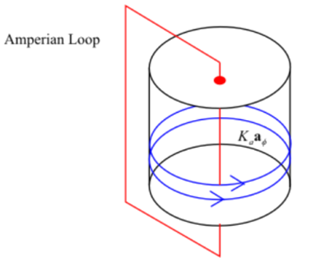
From the above diagram, the direction of surface current is
Therefore, magnetic field intensity is independent of any value of
From the same diagram, assume the length of the cylinder is infinite and the length of the loop is the finite dimension. At this condition, amperian loop cuts the infinite cylinder. Therefore, the net current remainsthe same for the amperian loop of the same dimension in the direction of z.
Therefore magnetic field intensity is independent of any value of z.
Conclusion:
Thus, it is proved that the H is not the function of
(b)
To show:
The value of
Answer to Problem 7.13P
It is proved that
It is proved that
Explanation of Solution
Given:
Radius of hollow cylindrical shell is 'a' which is centered on z- axis and carries uniform surface charge density of
Concept Used:
The concept of Ampere's circuital law and Biot's Savarts will be used. Ampere's circuital law says the closed integration of magnetic field along the path is equal to the product of current within that path and the medium. The mathematical expression is given as-
Where,
H = magnetic field
μ0 = permittivity of the medium
Ienclosed = current within the path
Biot Savart's law is used to calculate the magnetic field generated by the current carrying wire and helps to determine its strength at different points. It helps to relate magnetic field, direction, length, and proximity of electric current. Biot Savart's equation in terms of surface charge density is given as-
Where,
K = surface charge density
Calculation:
As the component
The magnetic field produces the direction of az because the amperian loop encloses the current flowing the direction of az, but there is no current in the direction of az.
Therefore,
The unit vector of the inside loop of the cylinder is given as-
By using Biot Savart's law, we can get the direction of the field which is obtained by K×aR. The component az of aR results in the radial component of magnetic field intensity which is given as-
Where, charge density is
Obtained radial components are opposite to the point at the end of the diameter of the hollow cylinder for constant z.
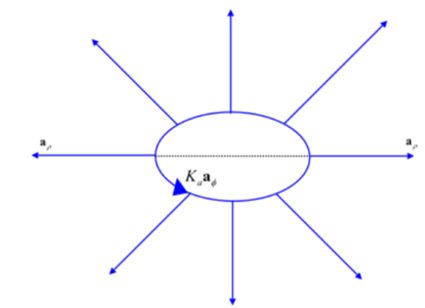
For each current element there is radial component, but these radial elements cancel out by the current element which is located diametrically opposite of radial element at same z. Therefore, the radial component for hollow cylinder shell is
Conclusion:
It is proved that the value of
(c)
To prove:
The value of Hz = 0 for
Answer to Problem 7.13P
By usingAmpere's circuital law,
The current within cylinder is zero and the electric field outside the cylinder is zero. Therefore, the value of Hz = 0 for
Explanation of Solution
Given:
The radius of the hollow cylindrical shell is 'a' which is centered on z -axis and carries uniform surface charge density of
Concept Used:
In this concept of Ampere's circuital law will be used. Ampere's law states the relationship between the current and the magnetic field. It says the closed integration of magnetic field along the path is equal to the product of current within that path and the medium. The mathematical expression is given as-
Where,
H = magnetic field
μ0 = permittivity of the medium
Ienclosed = current within the path
Calculation:
Hollow cylinder along with amperian loop around it is shown below-
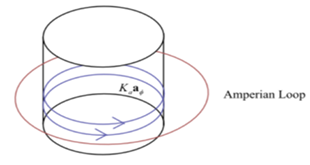
Amperian loop is when the surface charge current element within this loop is given below-

From the above two diagrams, the Amperian loop encompasses the hollow cylindrical shell completely. Therefore, the current within cylinder is zero. So, the electric field outside the cylinder is zero. Thus, the value of the magnetic field is zero for
Conclusion:
By using Ampere's circuital law,
The current within cylinder is zero and the electric filed outside the cylinder is zero. Therefore, the value of
(d)
To prove:
The value of
Answer to Problem 7.13P
By using Biot Savarts equation in terms of surface charge density, the value of magnetic field is
Explanation of Solution
Given:
Radius of hollow cylindrical shell is 'a' which is centered on z -axis and carries uniform surface charge density of
Concept Used:
Biot Savart's law is used to calculate the magnetic field generated by the current carrying wire and helps to determine its strength at different points. It helps to relate magnetic field, direction, length, and proximity of electric current. Biot Savart's equation in terms of surface charge density is given as-
Where,
K = surface charge density
H = magnetic field
Calculation:
Here, a magnetic field is to be calculated at the inside points of the cylinder as it doesn't exist outside the cylinder.
The unit vector of the inside loop of the cylinder is given as-
Biot Savart equation can be written in terms of surface charge density, which is given as-
Where, K is surface charge density, which given as-
Put the value of K and ar in the equation-
As it is already proved that H does not vary with z.
In above equation, put
Limits of θ
On integration
Conclusion:
The value of the magnetic field is
(e)
The value of H everywhere.
Answer to Problem 7.13P
Value of H is
Magnetic field for
Magnetic field for
Magnetic field for
Explanation of Solution
Given:
The radius of the hollow cylindrical shell is 'a' which is centered on z -axis and carries uniform surface charge density of
Concept Used:
In this concept of Ampere's circuital law will be used. Ampere's law states the relationship between the current and the magnetic field. It says the closed integration of magnetic field along the path is equal to the product of current within that path and the medium. The mathematical expression is given as-
Where,
H = magnetic field
μ0 = permitivity of the medium
Ienclosed = current within the path
Calculation:
Plot the amperian loop around the hollow cylinder to get the magnetic field everywhere-
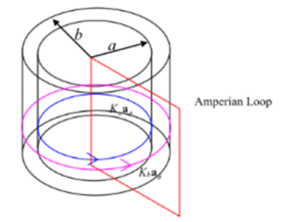
From the above diagram, the magnetic field for
Magnetic field for
Amperian loop for this is
Magnetic field for radius
In this case, no current is within the amperian loop, therefore magnetic field for this case is zero.
Conclusion:
Magnetic field for
Magnetic field for
Magnetic field for
Want to see more full solutions like this?
Chapter 7 Solutions
Engineering Electromagnetics
- In a spherical electrode system, gas material with the most favorable arrangement in terms of puncture resistance, outer radius r2 = 3.2 cm, puncture field strength Ed=75kV/cm and dielectric constant Ergas=1 is used. According to this;a) Calculate the inner radius of the electrode and the puncture voltage of the system according to the geometrical characteristics of the most suitable arrangement in terms of puncture resistance.b) Draw the puncture curve in the p-Emax plane for a voltage of U=40kV provided the outer radius is kept constant and indicate the boundaries of the inner sphere radii on the curve.c) Briefly interpret the electrode system in terms of discharge events in the geometric characteristics of p=0.8, p=1.8 and p=5 on the puncture curve.arrow_forwardAn infinitely long uniform line charge is located at y = 3, z = 5 if ρL = 30nC/m, find E at: (a) the origin; (b) PB(0,6,1); (c) PC(5,6,1).arrow_forwardWithin the cylinder ρ=5 (m), 0≤z≤1 (m), the potential field is given by V=100+50ρ+150ρ sin Φ Determine the electric field intensity at P(1, π/3, 0.5) in free space and in CCS.arrow_forward
- In a certain region of empty space, Bz=at (where a is a constant with units of N*C-1m-1), but Bx=By=0. (a) What is the magnitude and direction of the electric curl at that point in terms of a? (b) Assume that E̅ always points in the +x direction and is zero at y=0. Find Ex as a function of position and time. (c) Suppose that a=1.0T/s. What is the numerical rate at which Ex increases or decreases with y at a given instant of time? Do the units make sense?arrow_forwardIt is viewed from the cross-section of a coaxial cable consisting of a cylindrical conductive tube with an internal radius R and an outer radius of Rz wrapped around a cylindrical conductive wire with a RADIUS of R. r to indicate the radial distance from the center, the inner cylindrical conductor,if it is j1 = Gr and the outer conductive tube, j2 = Car has improper current densities. Here, the two conductors carry the same I flow in zit directions. What is the size of the B2 magnetic fields at r=1 cm and B2 at r= 8 cm?(R=4 cm; R=7 cm, R3=9 cm; Io=2 A; uo=47.10-7 T.m/A and our aquani-positive forehead outward from the page plane).arrow_forwardThere are point loads ,Q1 = 5, Q2 = 8 and Q3 = 6 at points A(-8,0), O(0,0) and B (6,0) in the OXY plane, respectively.Write the value of the x-component of the electric field in ke numerically at the point P(0, 10) on the-axis.arrow_forward
- There are point loads ,Q1 = 5, Q2 = 8 and Q3 = 6 at points A(-8,0), O(0,0) and B (6,0) in the OXY plane, respectively. Write the value of the x-component of the electric field in ke numerically at the point P(0, 10) on the-axis.arrow_forwardThe structure in the figure has 4 concentric spherical media,which have;0<r<a free spacea<r<b ρv (C/m3) constant volume charge densityb<r<c εr relative permittivityc<r free spaceFind ?⃗ , ?⃗ and ?⃗ in these 4 regions and also plot themarrow_forwardA ring and a disk both are centered at (7, 6, 5) and are both lying on the plane y = 6. The ring has a radius of 7 m, while the disk has a radius of 9 m, so that the ring is around the disk. Determine the magnitude of the electric field in kV/m at point (7, -7, 5) if the ring has a total charge of -5 mC and the disk has a total charge of 7 mC. All coordinates are measured in meters.arrow_forward
- Design a uniformly-stressed coaxial cylindrical electrode system using threedifferent insulating materials with relative dielectric constants 2.5, 4, and 6(determine the layer thicknesses for the inner and outer radiuses of case-a).Calculate the maximum field strength of the layers for a test voltage of U = 200 kV.arrow_forwardA hollow sphere, with inner radius a and outer radius b, has a volumetric charge distribution p = kr^2, where r is the distance from the center of the sphere outwards and k is a known constant. Using Gauss's law, find the electric field at r < a, a < r < b, and r > b, and graph the electric field as a function of r.arrow_forwardPlease write to text format The charge per unit length on the thin rod shown below is ?. What is the electric field at the point P? (Hint: Solve this problem by first considering the electric field dE at P due to a small segment dx of the rod, which contains charge dq = ? dx. Then find the net field by integrating dE over the length of the rod. Use the following as necessary: L, a, ?, and ?0. Enter the magnitude. Assume that ? is positive.) Earrow_forward
 Introductory Circuit Analysis (13th Edition)Electrical EngineeringISBN:9780133923605Author:Robert L. BoylestadPublisher:PEARSON
Introductory Circuit Analysis (13th Edition)Electrical EngineeringISBN:9780133923605Author:Robert L. BoylestadPublisher:PEARSON Delmar's Standard Textbook Of ElectricityElectrical EngineeringISBN:9781337900348Author:Stephen L. HermanPublisher:Cengage Learning
Delmar's Standard Textbook Of ElectricityElectrical EngineeringISBN:9781337900348Author:Stephen L. HermanPublisher:Cengage Learning Programmable Logic ControllersElectrical EngineeringISBN:9780073373843Author:Frank D. PetruzellaPublisher:McGraw-Hill Education
Programmable Logic ControllersElectrical EngineeringISBN:9780073373843Author:Frank D. PetruzellaPublisher:McGraw-Hill Education Fundamentals of Electric CircuitsElectrical EngineeringISBN:9780078028229Author:Charles K Alexander, Matthew SadikuPublisher:McGraw-Hill Education
Fundamentals of Electric CircuitsElectrical EngineeringISBN:9780078028229Author:Charles K Alexander, Matthew SadikuPublisher:McGraw-Hill Education Electric Circuits. (11th Edition)Electrical EngineeringISBN:9780134746968Author:James W. Nilsson, Susan RiedelPublisher:PEARSON
Electric Circuits. (11th Edition)Electrical EngineeringISBN:9780134746968Author:James W. Nilsson, Susan RiedelPublisher:PEARSON Engineering ElectromagneticsElectrical EngineeringISBN:9780078028151Author:Hayt, William H. (william Hart), Jr, BUCK, John A.Publisher:Mcgraw-hill Education,
Engineering ElectromagneticsElectrical EngineeringISBN:9780078028151Author:Hayt, William H. (william Hart), Jr, BUCK, John A.Publisher:Mcgraw-hill Education,





